Top 12 SolarWinds Competitors and Alternatives In 2025
Organizations exploring SolarWinds alternatives often face a critical decision when choosing the right network and infrastructure monitoring solution. While SolarWinds has established itself as a reliable industry standard, companies are increasingly seeking alternatives that offer better alignment with their monitoring needs, budget constraints, and security requirements. This comprehensive guide examines the top competitors and alternatives to SolarWinds Network Performance Monitor, helping you make an informed decision for your 2025 monitoring strategy.
What is SolarWinds?
SolarWinds is a comprehensive IT management software suite that provides network and infrastructure monitoring capabilities. Founded in 1999, the platform has evolved to become one of the leading solutions in the network monitoring space, known for its Network Performance Monitor (NPM) and other integrated tools.
Core Capabilities of SolarWinds
- Network Performance Monitoring:
- Real-time network monitoring
- Automated device discovery
- Network mapping and visualization
- Bandwidth analysis and traffic monitoring
- Infrastructure Management:
- Server and application monitoring
- Storage resource management
- Virtualization monitoring
- Cloud infrastructure oversight
- Security and Compliance:
- Security event tracking
- Compliance reporting
- Access control management
- Log and event correlation
Market Position
| Aspect | Details |
|---|---|
| Market Share | Approximately 20% of enterprise network monitoring market |
| Primary Users | Medium to large enterprises |
| Deployment Options | On-premises and hybrid |
| Pricing Model | Module-based licensing |
| Key Industries | Healthcare, Finance, Government, Education |
Why Organizations Seek Alternatives
Several factors have prompted organizations to explore SolarWinds alternatives:
- Security Considerations:
- The 2020 SUNBURST cyber attack affected thousands of organizations
- Increased focus on supply chain security
- Need for modern security architectures
- Technical Evolution:
- Rise of cloud-native architectures
- Containerization and microservices adoption
- Edge computing requirements
- DevOps integration needs
- Business Factors:
- Complex licensing models
- High total cost of ownership
- Support response times
- Implementation complexity
Essential Features of Modern Monitoring Solutions
The monitoring landscape has evolved significantly, with modern solutions offering comprehensive capabilities beyond traditional network monitoring. Here's a detailed look at what organizations should expect from contemporary monitoring platforms:
Network Monitoring and Analysis
Modern network monitoring solutions should provide deep visibility into network performance and health:
Real-time Monitoring Capabilities:
- Bandwidth utilization tracking
- Latency and packet loss detection
- Network flow analysis
- QoS monitoring and management
Network Discovery and Mapping:
- Automated device discovery
- Dynamic topology mapping
- Relationship visualization
- Configuration management
Infrastructure Oversight
Comprehensive infrastructure monitoring is crucial for maintaining system health:
Server Monitoring:
| Feature | Purpose | Impact |
|---|---|---|
| Resource Utilization | Track CPU, memory, disk usage | Prevent performance bottlenecks |
| Process Monitoring | Monitor critical system processes | Ensure service availability |
| Hardware Health | Track physical component status | Prevent hardware failures |
| Capacity Planning | Forecast resource needs | Optimize infrastructure costs |
Cloud Infrastructure:
- Multi-cloud monitoring capabilities
- Container and orchestration platform support
- Serverless function monitoring
- Cloud cost optimization
Application Performance Management
Modern APM capabilities are essential for maintaining service quality:
- End-User Experience Monitoring:
- Real user monitoring (RUM)
- Synthetic transaction monitoring
- User journey tracking
- Performance analytics
- Application Diagnostics:
- Code-level performance insights
- Transaction tracing
- Error tracking and analysis
- Service dependency mapping
Security and Compliance Features
Security integration has become crucial in modern monitoring solutions:
Security Capabilities Matrix:
| Feature | Basic | Advanced | Enterprise |
|---|---|---|---|
| Access Control | ✓ | ✓ | ✓ |
| Audit Logging | ✓ | ✓ | ✓ |
| Encryption | ✓ | ✓ | ✓ |
| Compliance Reporting | - | ✓ | ✓ |
| Threat Detection | - | ✓ | ✓ |
| Security Analytics | - | - | ✓ |
Integration and Automation
Modern solutions must provide robust integration capabilities:
- API and Integration Support:
- RESTful API access
- Webhook support
- Custom integration options
- Pre-built integrations with popular tools
- Automation Capabilities:
- Automated remediation
- Workflow automation
- Script execution
- Custom automation rules
Top 12 SolarWinds Alternatives Detailed Analysis
When searching for a SolarWinds Network Performance Monitor alternative or exploring open source SolarWinds alternatives, it's essential to understand each solution's unique value proposition. Let's dive into detailed analysis of each option:
Cisco Network Management

As a premium SolarWinds alternative, Cisco Network Management delivers enterprise-grade monitoring capabilities with exceptional integration for Cisco environments. The platform stands out for its comprehensive network visibility and advanced AI-powered analytics.
Key Features:
- End-to-end network visibility
- AI-powered analytics and automation
- Advanced security features
- Real-time performance monitoring
- Comprehensive device management
- Custom reporting and alerting
| Advantages | Limitations |
|---|---|
| ✓ Superior Cisco integration | ✗ High implementation costs |
| ✓ Enterprise-grade security | ✗ Steep learning curve |
| ✓ Powerful automation | ✗ Complex setup process |
| ✓ Comprehensive reporting | ✗ Limited non-Cisco support |
| ✓ Scalable architecture | ✗ Expensive for small teams |
Pricing: Enterprise-level solution starting from $20,000 annually. Custom quotes based on infrastructure size and requirements.
Best For: Large enterprises with substantial Cisco infrastructure investments and dedicated IT teams requiring comprehensive network monitoring capabilities.
Uptrace
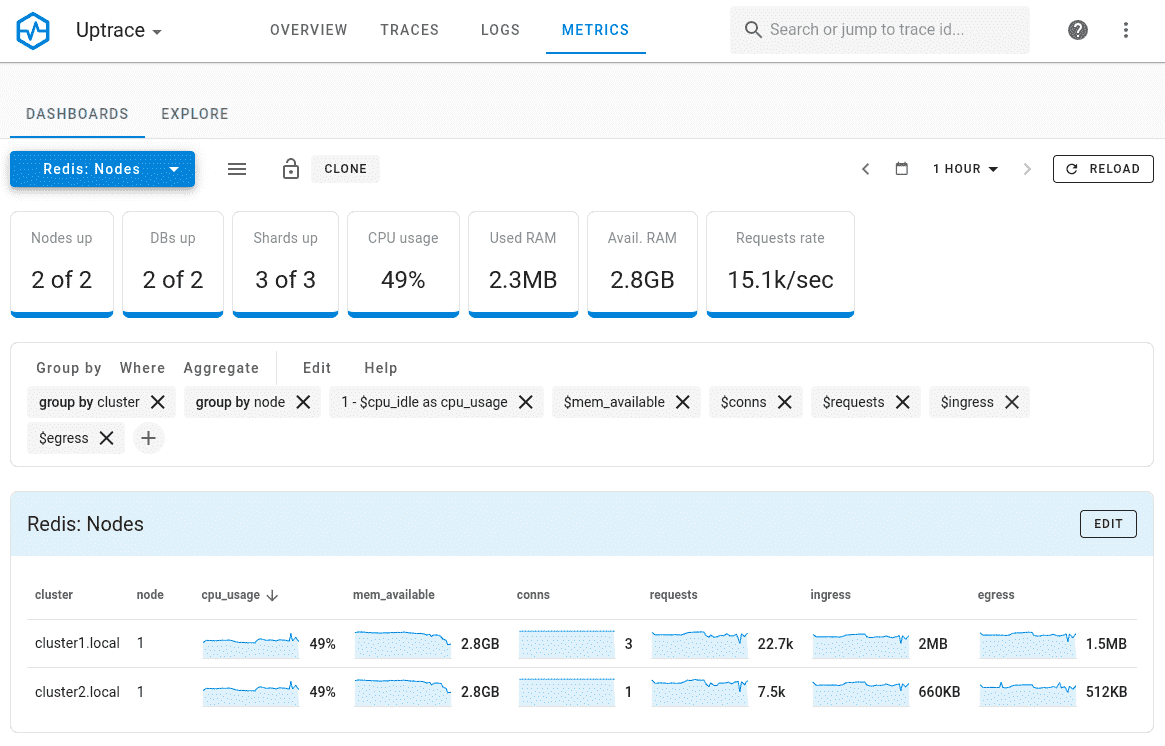
A modern alternative to traditional monitoring solutions, Uptrace combines powerful distributed tracing capabilities with performance monitoring in a developer-friendly package. Its OpenTelemetry-native approach makes it particularly appealing for cloud-native applications.
Key Features:
- OpenTelemetry-native monitoring
- Distributed tracing at scale
- ClickHouse-powered analytics
- Real-time performance metrics
- Custom dashboards and alerts
- Comprehensive API access
| Advantages | Limitations |
|---|---|
| ✓ Minimal overhead | ✗ Newer in market |
| ✓ Quick implementation | ✗ Limited enterprise references |
| ✓ Strong community | ✗ Features in development |
| ✓ Great documentation | ✗ Smaller ecosystem |
| ✓ Cost-effective | ✗ Learning curve for ClickHouse |
Pricing: Free open-source version available. Commercial plans start at $100/month based on data volume.
Best For: DevOps-focused teams and organizations looking for a modern, cost-effective monitoring solution with strong OpenTelemetry support.
Datadog
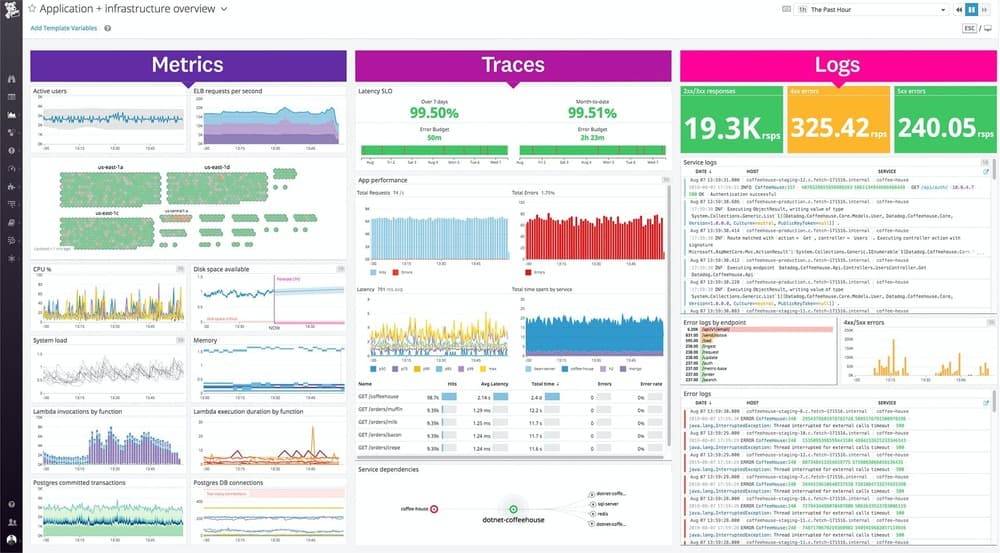
A comprehensive monitoring platform that has become a popular SolarWinds alternative, especially for cloud-native environments. Datadog excels in providing unified observability across infrastructure, applications, and logs with powerful integration capabilities.
Key Features:
- Full-stack observability platform
- 400+ built-in integrations
- Machine learning-powered analytics
- Real-time performance monitoring
- Custom dashboards and alerts
- Automated infrastructure discovery
| Advantages | Limitations |
|---|---|
| ✓ Extensive integration ecosystem | ✗ Complex pricing structure |
| ✓ Excellent cloud monitoring | ✗ Can become expensive at scale |
| ✓ User-friendly interface | ✗ Some features require higher tiers |
| ✓ Strong API support | ✗ Limited historical data retention |
| ✓ Regular feature updates | ✗ Learning curve for advanced features |
Pricing: Infrastructure monitoring starts at $15/host/month. APM features start at $31/host/month.
Best For: Cloud-native organizations and enterprises requiring comprehensive monitoring capabilities with strong cloud platform integration.
Nagios
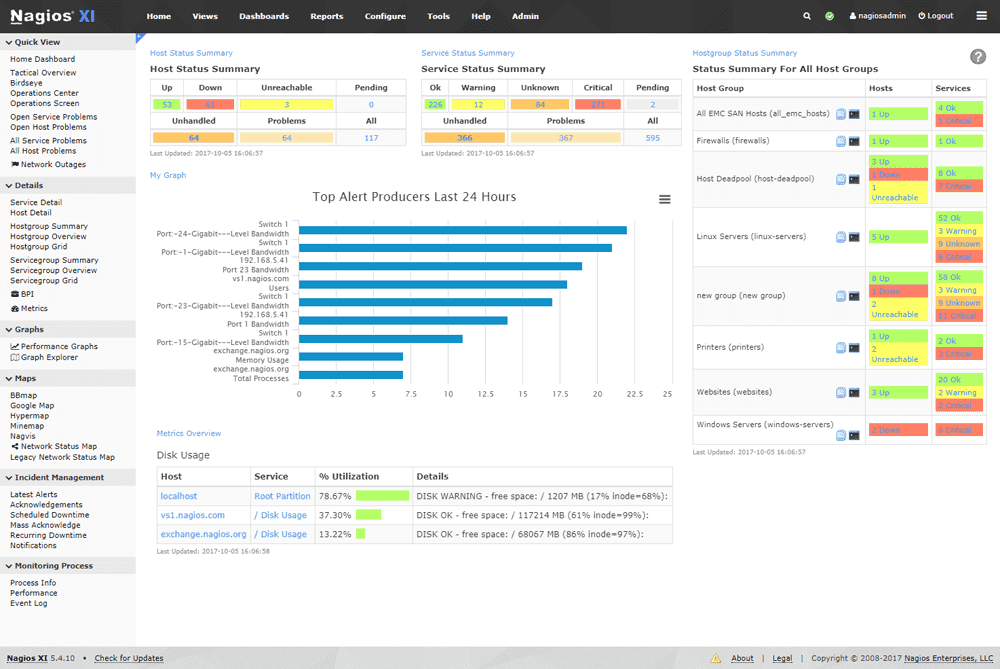
As one of the most established open source SolarWinds alternatives, Nagios offers robust monitoring capabilities and has maintained a strong presence in the IT monitoring space for over two decades. Its extensive plugin ecosystem makes it highly adaptable to various monitoring needs.
Key Features:
- Extensive plugin architecture
- Network and infrastructure monitoring
- Performance tracking
- Alert management system
- Customizable reporting
- Multi-tenant capabilities
| Advantages | Limitations |
|---|---|
| ✓ No licensing costs (Core version) | ✗ Complex initial setup |
| ✓ Large community support | ✗ Dated user interface |
| ✓ Extensive customization options | ✗ Manual configuration required |
| ✓ Rich plugin ecosystem | ✗ Limited modern integrations |
| ✓ Proven reliability | ✗ Steep learning curve |
Pricing: Nagios Core is free and open-source. Nagios Standard starts at $2,495 per 100 Node.
Best For: Organizations seeking a proven, cost-effective monitoring solution and having technical expertise for configuration and maintenance.
Zabbix
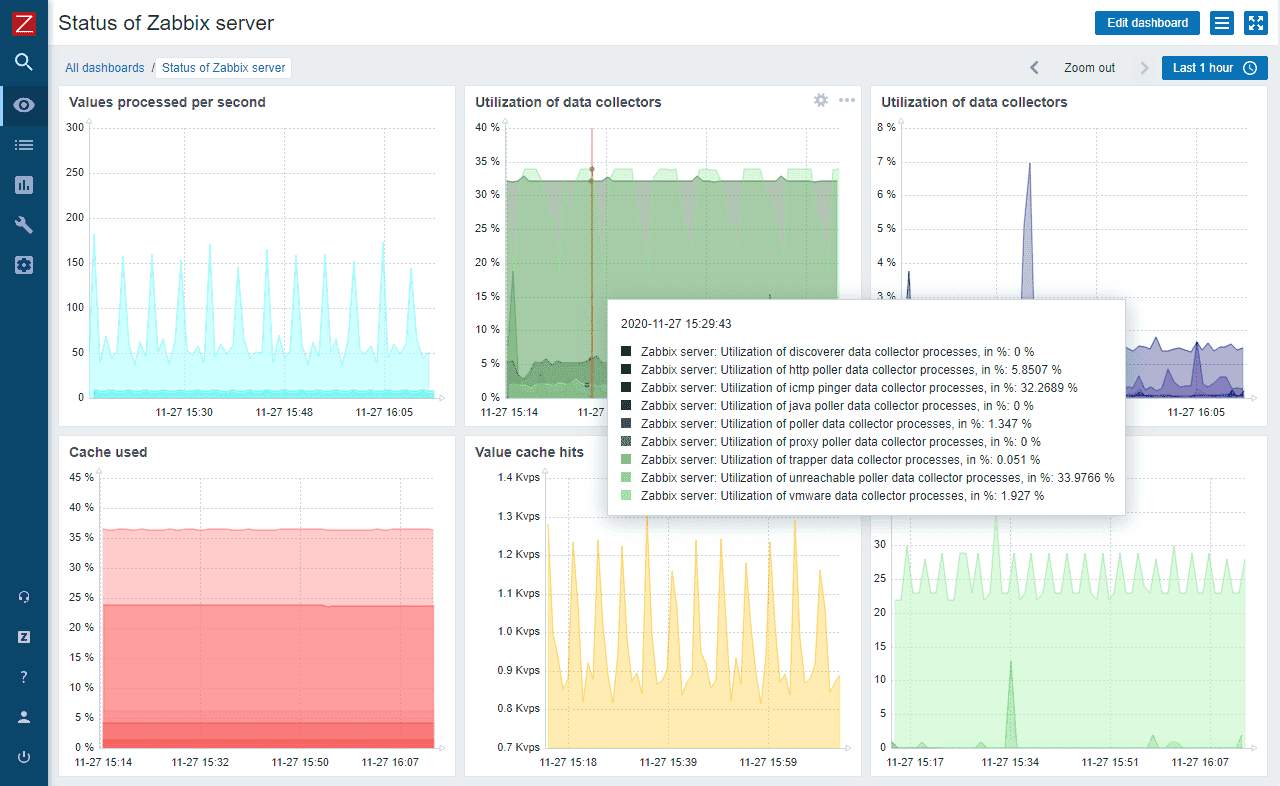
A powerful open source SolarWinds alternative that combines modern features with enterprise-grade scalability. Zabbix provides comprehensive monitoring capabilities while maintaining the flexibility of an open-source solution.
Key Features:
- Automated device discovery
- Predictive monitoring
- Custom alerting system
- Template-based configuration
- Distributed monitoring
- Extensive data collection options
| Advantages | Limitations |
|---|---|
| ✓ Free open-source platform | ✗ Resource-intensive |
| ✓ Enterprise-grade features | ✗ Complex configuration |
| ✓ Active development | ✗ Limited cloud monitoring |
| ✓ Strong security features | ✗ Requires expertise |
| ✓ Scalable architecture | ✗ Basic UI/UX |
Pricing: Free open-source software. Enterprise support and consulting services available at additional cost.
Best For: Organizations looking for a free, feature-rich monitoring solution with the resources to handle deployment and maintenance.
ManageEngine OpManager
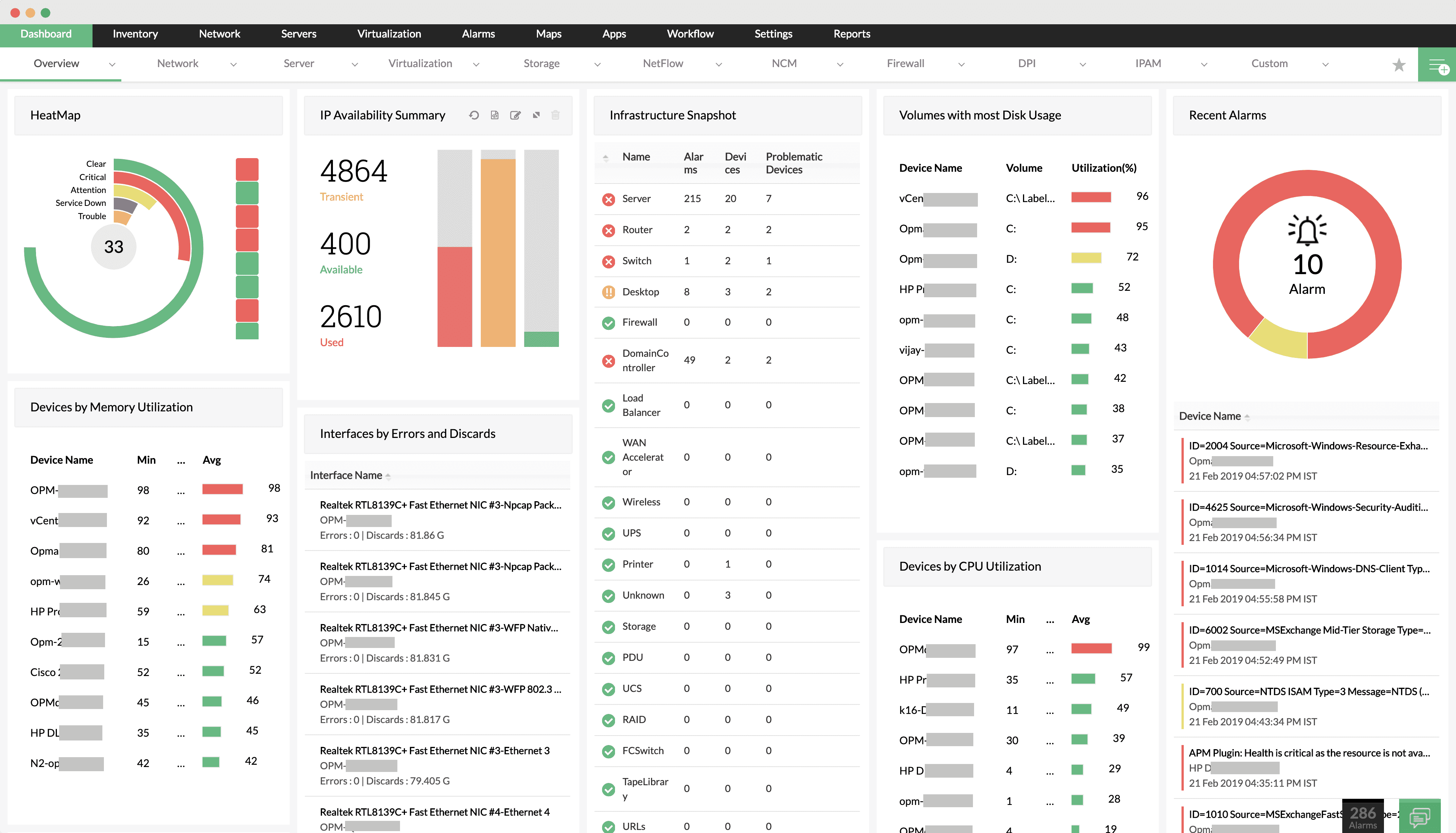
A comprehensive alternative to SolarWinds Network Performance Monitor that offers robust network monitoring and management capabilities. ManageEngine OpManager stands out for its balance of features and ease of use, making it particularly attractive for mid-sized businesses.
Key Features:
- Real-time network monitoring
- Automated network mapping
- Bandwidth analysis
- Server and storage monitoring
- IPAM and Switch Port Mapping
- Physical and virtual server monitoring
| Advantages | Limitations |
|---|---|
| ✓ User-friendly interface | ✗ Limited customization options |
| ✓ Comprehensive monitoring | ✗ Some features require add-ons |
| ✓ Good value for money | ✗ Advanced features cost extra |
| ✓ Easy deployment | ✗ Basic reporting capabilities |
| ✓ Strong support | ✗ Limited cloud monitoring |
Pricing: Standard edition starts at $245 for 25 devices. Enterprise edition from $11,545 for 250 devices.
Best For: Mid-sized organizations seeking a balanced monitoring solution with straightforward implementation and management.
PRTG Network Monitor
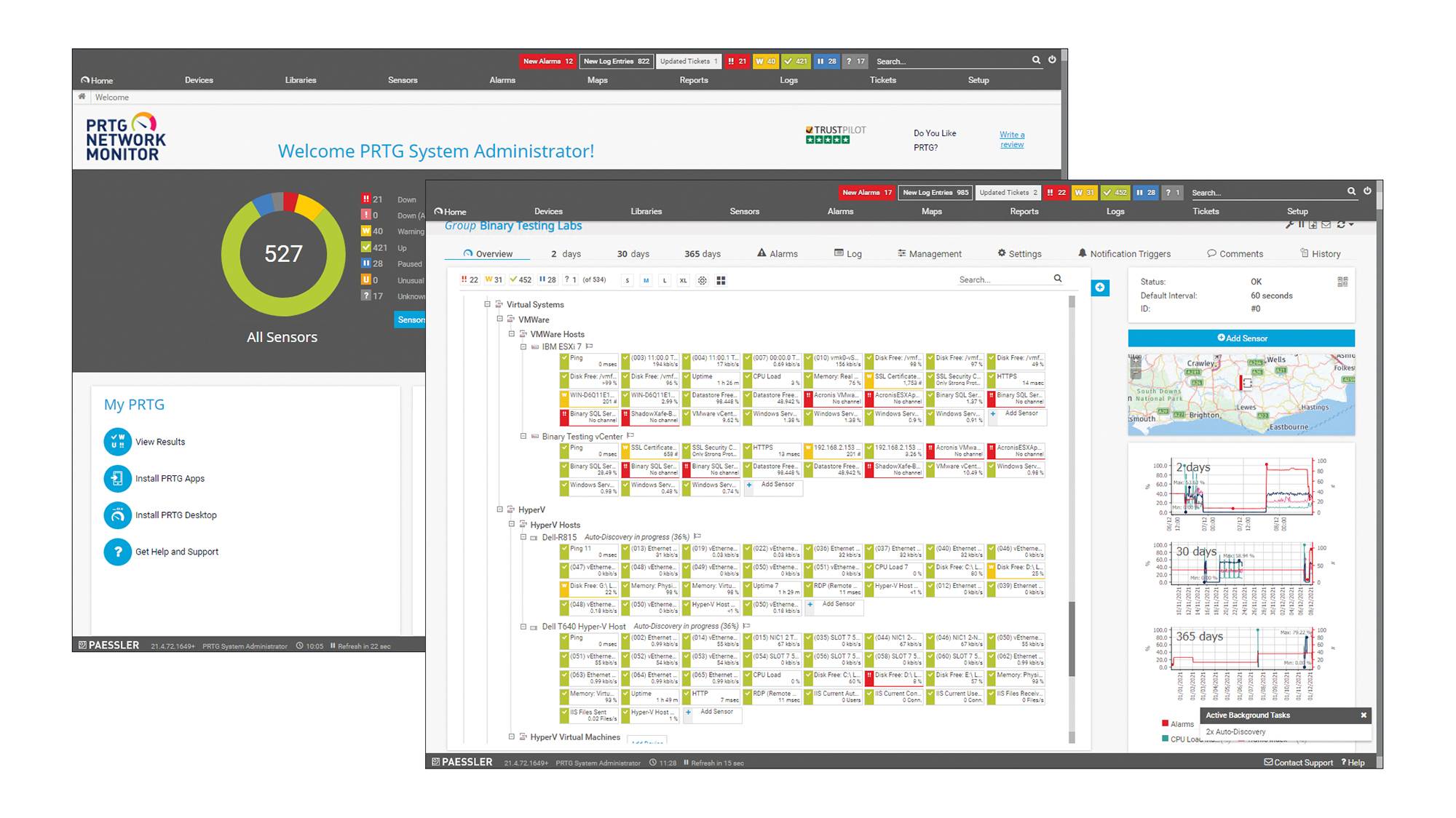
PRTG offers a comprehensive network monitoring solution with an all-in-one approach, making it a strong SolarWinds alternative for organizations preferring simplified licensing and deployment.
Key Features:
- All-inclusive sensor-based monitoring
- Auto-discovery capabilities
- Custom dashboards
- Mobile app access
- Distributed monitoring
- Extensive notification system
| Advantages | Limitations |
|---|---|
| ✓ Simple licensing model | ✗ Windows-only server |
| ✓ Intuitive interface | ✗ Limited public cloud monitoring |
| ✓ Comprehensive sensors | ✗ Basic reporting features |
| ✓ Good visualization tools | ✗ Less flexible than competitors |
| ✓ Easy to set up | ✗ Limited custom integrations |
Pricing: Free for up to 100 sensors. Commercial licenses start at $1,750 for 500 sensors.
Best For: Windows-centric organizations looking for an easy-to-use, comprehensive monitoring solution with straightforward pricing.
LogicMonitor
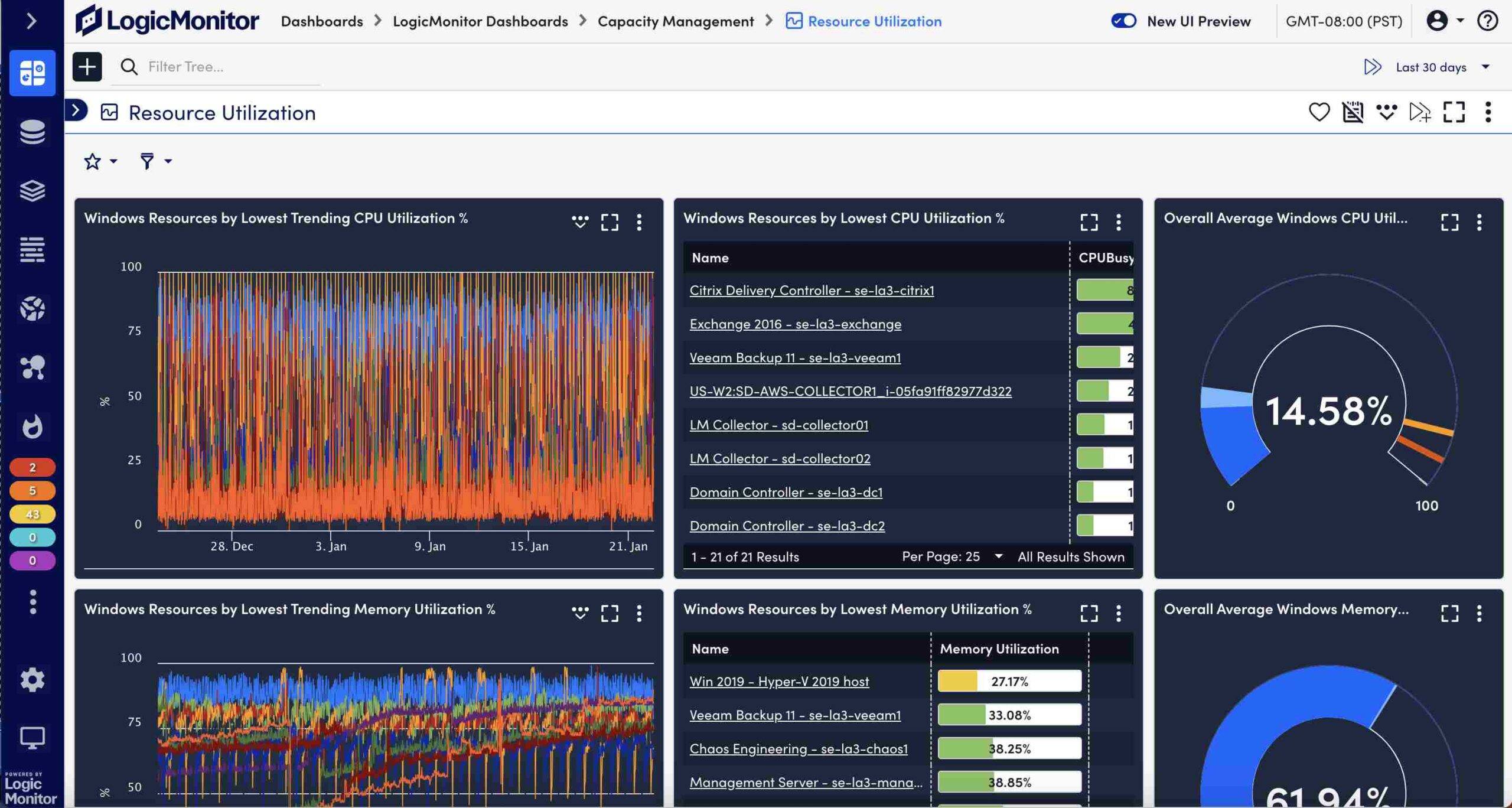
A SaaS-based monitoring platform that provides extensive infrastructure monitoring capabilities with automated discovery and monitoring of the entire IT infrastructure. LogicMonitor excels in providing unified visibility across hybrid environments.
Key Features:
- Automated device discovery
- Dynamic topology mapping
- AIOps capabilities
- Comprehensive API
- Multi-tenant architecture
- Forecasting and planning tools
| Advantages | Limitations |
|---|---|
| ✓ Excellent automation | ✗ Higher price point |
| ✓ Strong cloud support | ✗ Complex initial setup |
| ✓ Predictive analytics | ✗ Steep learning curve |
| ✓ Good scalability | ✗ Advanced features cost extra |
| ✓ Regular updates | ✗ Limited customization |
Pricing: Custom pricing based on monitored devices and data points. Contact vendor for quotes.
Best For: Enterprise organizations requiring comprehensive hybrid infrastructure monitoring with strong automation capabilities.
Prometheus + Grafana
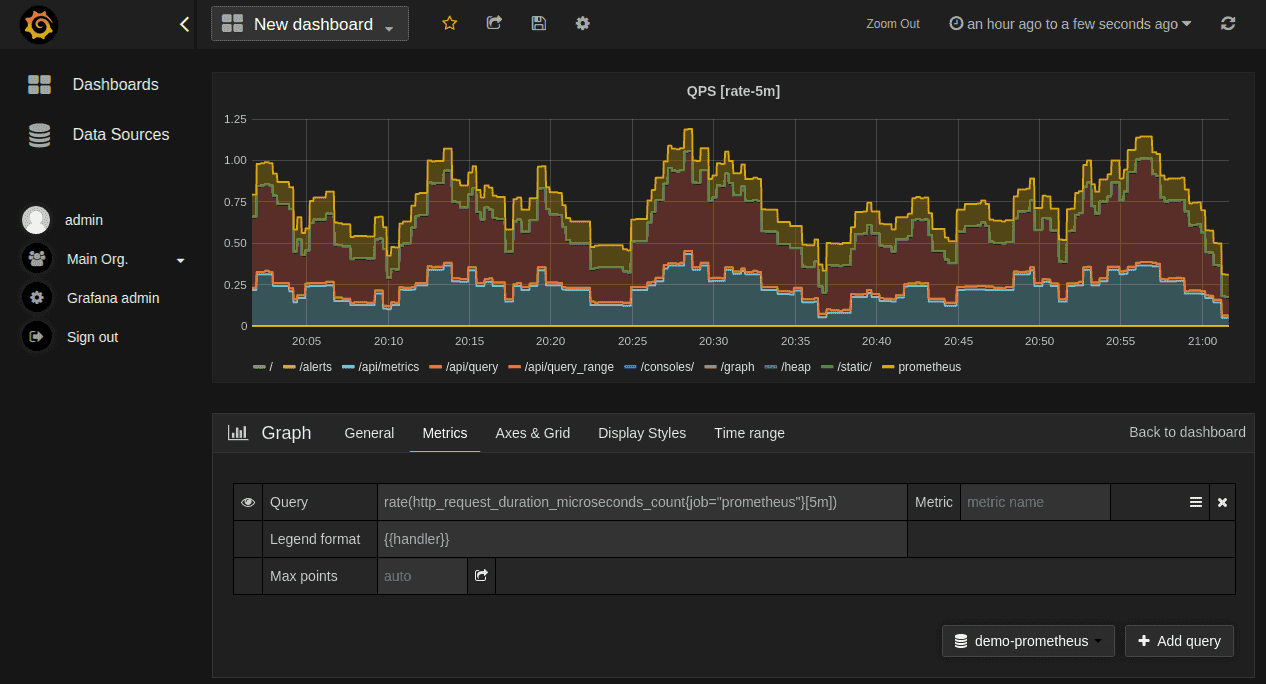
A powerful open source SolarWinds alternative Prometheus + Grafana combining Prometheus's monitoring capabilities with Grafana's visualization prowess. This stack has become the de facto standard for monitoring cloud-native environments and Kubernetes clusters.
Key Features:
- Time-series data collection
- PromQL query language
- Kubernetes native monitoring
- Alert management
- Custom visualization
- Extensive exporter ecosystem
| Advantages | Limitations |
|---|---|
| ✓ Free open-source solution | ✗ Complex initial setup |
| ✓ Cloud-native ready | ✗ Limited long-term storage |
| ✓ Strong community | ✗ Requires technical expertise |
| ✓ Flexible metrics collection | ✗ Manual configuration needed |
| ✓ Beautiful dashboards | ✗ Limited Windows monitoring |
Pricing: Free and open-source. Enterprise support available through various vendors.
Best For: Organizations running cloud-native applications and Kubernetes clusters who need powerful, customizable monitoring capabilities.
WhatsUp Gold
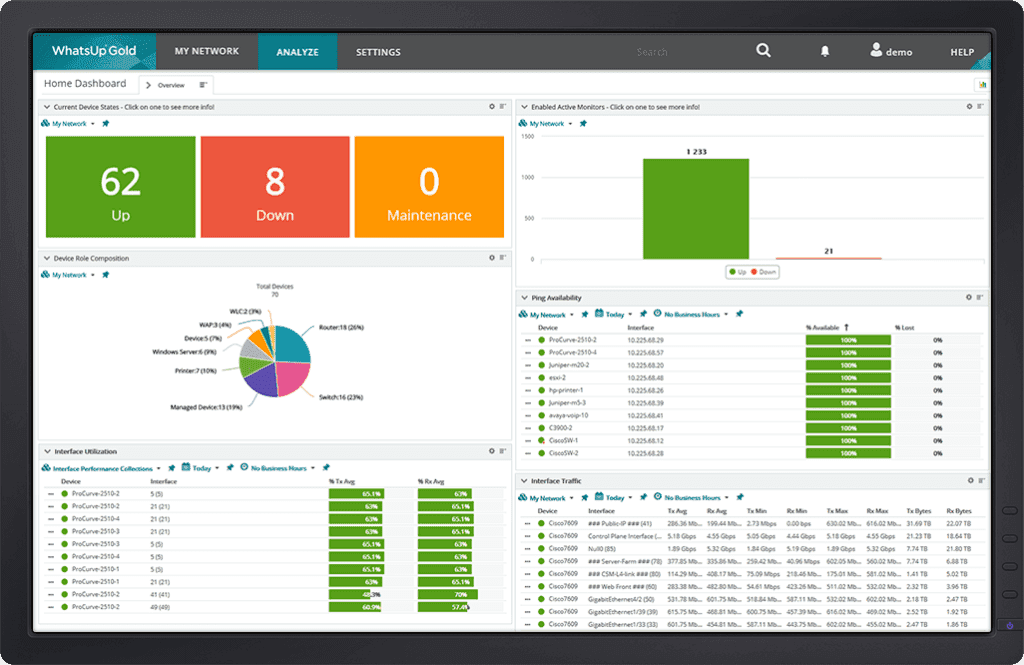
A traditional alternative to SolarWinds that has evolved to offer modern monitoring capabilities while maintaining its focus on network monitoring and management. WhatsUp Gold provides a comprehensive solution for organizations prioritizing network visibility.
Key Features:
- Network discovery and mapping
- Performance monitoring
- Application monitoring
- Cloud resource monitoring
- Wireless network monitoring
- Configuration management
| Advantages | Limitations |
|---|---|
| ✓ Easy to deploy | ✗ Limited cloud capabilities |
| ✓ Good network visibility | ✗ Basic application monitoring |
| ✓ Intuitive interface | ✗ Windows-only deployment |
| ✓ Strong alerting system | ✗ Limited scalability |
| ✓ Unified dashboard | ✗ Less modern interface |
Pricing: Free edition. Commercial plans starts at $899 for 50 devices. Enterprise edition available with additional features.
Best For: Small to medium-sized businesses seeking a reliable network monitoring solution with straightforward implementation.
Auvik
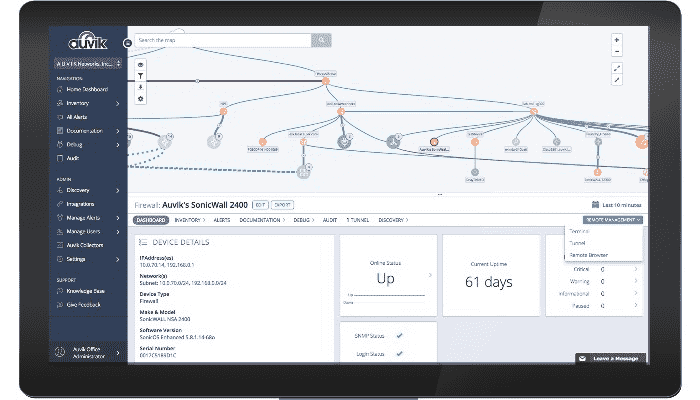
A cloud-based network monitoring solution that emphasizes automation and ease of use. Auvik has gained popularity as a SolarWinds alternative, particularly among managed service providers (MSPs) and IT teams seeking simplified network management.
Key Features:
- Automated network mapping
- Configuration backup
- Network traffic analysis
- Remote access capabilities
- Automated device discovery
- Real-time monitoring
| Advantages | Limitations |
|---|---|
| ✓ Quick deployment | ✗ Limited customization |
| ✓ MSP-friendly features | ✗ Higher cost per device |
| ✓ Strong automation | ✗ Basic reporting features |
| ✓ Cloud-based management | ✗ Limited application monitoring |
| ✓ Good documentation | ✗ Focused mainly on networks |
Pricing: Based on number of network devices. Contact vendor for custom quotes.
Best For: MSPs and organizations seeking a cloud-based, automated network monitoring solution with minimal setup requirements.
Atera
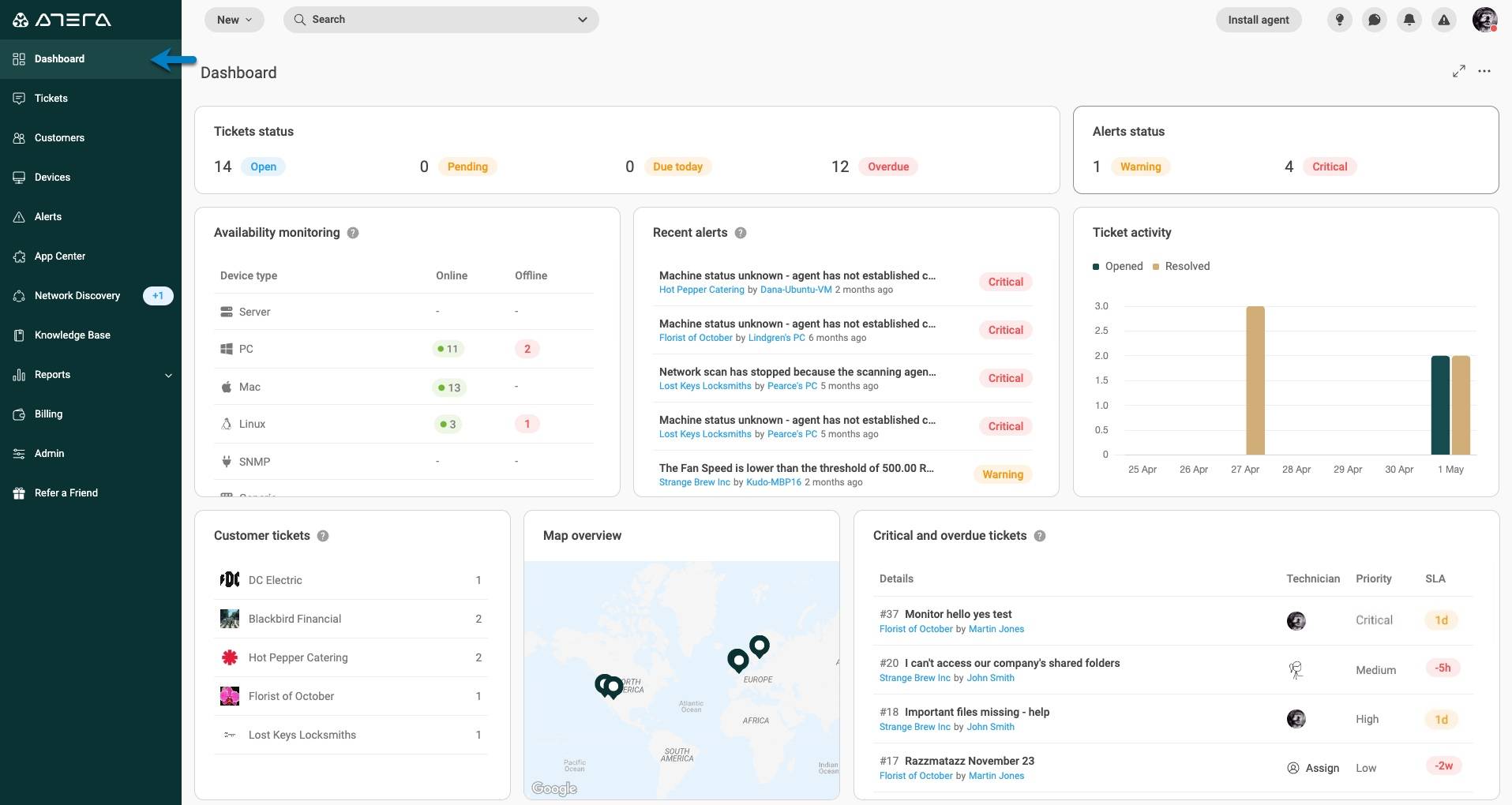
An all-in-one RMM (Remote Monitoring and Management) platform that offers a unique per-technician pricing model. While not a traditional SolarWinds replacement, Atera provides comprehensive monitoring capabilities alongside IT management features.
Key Features:
- Remote monitoring
- Patch management
- IT automation
- Remote access
- Asset management
- Professional services automation
| Advantages | Limitations |
|---|---|
| ✓ Per-technician pricing | ✗ Limited enterprise features |
| ✓ All-in-one solution | ✗ Basic monitoring capabilities |
| ✓ Easy to use | ✗ Limited customization options |
| ✓ Built-in remote access | ✗ Less sophisticated reporting |
| ✓ Good for MSPs | ✗ Limited integration options |
Pricing: From $149/month per technician, including unlimited devices and endpoints.
Best For: Small to medium-sized MSPs and IT teams looking for an affordable, comprehensive IT management and monitoring solution.
Feature Comparison Matrix
When evaluating SolarWinds alternatives, it's crucial to compare key features across solutions. Here's a comprehensive comparison matrix:
| Feature | SolarWinds | Uptrace | Datadog | Cisco | Nagios | Zabbix | PRTG | LogicMonitor |
|---|---|---|---|---|---|---|---|---|
| Network Monitoring | ✓✓ | ✓ | ✓✓ | ✓✓✓ | ✓✓ | ✓✓ | ✓✓ | ✓✓ |
| Infrastructure Monitoring | ✓✓ | ✓✓ | ✓✓✓ | ✓✓ | ✓✓ | ✓✓ | ✓✓ | ✓✓✓ |
| APM Capabilities | ✓ | ✓✓✓ | ✓✓✓ | ✓ | ✗ | ✓ | ✓ | ✓✓ |
| Cloud Monitoring | ✓ | ✓✓✓ | ✓✓✓ | ✓ | ✗ | ✓ | ✓ | ✓✓✓ |
| Distributed Tracing | ✓ | ✓✓✓ | ✓✓✓ | ✓ | ✗ | ✓ | ✗ | ✓✓ |
| Automation | ✓✓ | ✓✓ | ✓✓✓ | ✓✓✓ | ✓ | ✓✓ | ✓✓ | ✓✓✓ |
| Ease of Setup | ✓ | ✓✓✓ | ✓✓ | ✗ | ✗ | ✓ | ✓✓ | ✓ |
Legend: ✓✓✓ Excellent, ✓✓ Good, ✓ Basic, ✗ Limited/None
Pricing Comparison
Understanding the cost structure of each solution is essential for making an informed decision:
Enterprise Solutions
| Solution | Starting Price | Pricing Model | Free Trial |
|---|---|---|---|
| SolarWinds | $1,995+ | Per node | 30 days |
| Cisco | $20,000+ | Enterprise | Custom |
| DataDog | $15/host | Per host | 14 days |
| LogicMonitor | Custom | Per device | 14 days |
| ManageEngine OpManager | $245 | Per device | 30 days |
Mid-Market Solutions
| Solution | Starting Price | Pricing Model | Free Trial |
|---|---|---|---|
| Uptrace | $100/month | Data volume | Free tier |
| PRTG | $1,750 | Per sensor | 30 days |
| WhatsUp Gold | $899 | Per device | 30 days |
| Auvik | Custom | Per device | 14 days |
Open Source Options
| Solution | Community Edition | Enterprise Support | Training |
|---|---|---|---|
| Nagios | Free | From $2,495 | Paid |
| Zabbix | Free | Custom | Available |
| Prometheus + Grafana | Free | Via partners | Community |
Making the Right Choice
Understanding your organization's specific needs and resources is шьзщкефте when selecting a SolarWinds alternative. Here are recommendations for different business scenarios.
Factors to Consider
| Business Size | Technical Needs | Resource Factors |
|---|---|---|
| Enterprise (1000+ devices) | Network complexity | Budget constraints |
| Mid-market (100-1000 devices) | Cloud presence | Technical expertise |
| Small business (<100 devices) | Application stack | Implementation timeline |
| Integration requirements | Support needs |
Recommendations by Use Case
| Business Type | Solution Category | Recommended Tool |
|---|---|---|
| Large Enterprise | Best Overall | Cisco Network Management |
| Best Cloud-Native | Datadog | |
| Best Value | LogicMonitor | |
| Mid-Size Organizations | Best Overall | Uptrace |
| Best Network Monitoring | PRTG | |
| Best Budget Option | ManageEngine OpManager | |
| Small Business | Best Overall | Auvik |
| Best Open Source | Zabbix | |
| Best Value | Atera | |
| MSPs | Best Overall | Auvik |
| Best Scalability | LogicMonitor | |
| Best Budget | Atera |
Implementation Guidelines
Successfully transitioning from SolarWinds to an alternative solution requires careful planning and execution. Understanding the key phases and considerations will help ensure a smooth migration process.
Pre-Migration Planning
Before beginning the migration, conduct a thorough audit of your current environment. Document your existing monitoring coverage, critical systems, and custom configurations. This groundwork will serve as your roadmap throughout the migration process.
| Planning Aspect | Key Considerations |
|---|---|
| Infrastructure | Server requirements, storage needs, network capacity |
| Team Resources | Available expertise, training needs, support requirements |
| Timeline | Implementation duration, testing period, go-live date |
| Budget | Initial investment, ongoing costs, training expenses |
Migration Strategy
A successful migration follows a three-phase approach to minimize disruption and ensure proper validation of the new system.
Phase 1: Preparation The initial phase focuses on setting up the new environment while maintaining existing monitoring. This includes basic configuration, user setup, and establishing essential connectivity.
Phase 2: Parallel Operation During this critical phase, both systems run simultaneously. Start migrating non-critical systems first, allowing for thorough testing and validation of the new solution's accuracy and reliability.
Phase 3: Cutover The final phase involves completing the transition to the new system, including historical data migration where possible and decommissioning the old system.
Best Practices for Implementation
Focus on establishing a solid foundation before adding complexity. Begin with core monitoring requirements and gradually expand capabilities as your team becomes more familiar with the new system.
| Implementation Focus | Recommended Approach |
|---|---|
| Monitoring Scope | Start basic, expand gradually |
| Configuration | Use templates, document customizations |
| Testing | Thorough validation at each stage |
| Training | Regular sessions, practical exercises |
Post-Migration Optimization
After completing the migration, focus on optimizing your new monitoring solution for maximum effectiveness. Regular performance reviews and adjustments ensure your monitoring continues to meet your organization's needs.
Performance Tuning
The key to maintaining optimal performance lies in regular system assessment and adjustment. Monitor system resources, optimize configurations, and scale your solution according to actual usage patterns.
| Optimization Area | Action Items |
|---|---|
| System Performance | Adjust polling intervals, optimize data retention |
| Alert Configuration | Fine-tune thresholds, reduce alert noise |
| Resource Usage | Monitor agent impact, optimize collection methods |
| Reporting | Streamline reports, automate generation |
Future-Proofing Your Monitoring
Consider future growth and technological changes when implementing your new monitoring solution. Plan for scalability and stay informed about emerging monitoring capabilities that could benefit your organization.
| Future Consideration | Planning Focus |
|---|---|
| Growth Planning | Infrastructure expansion, new technology adoption |
| Technology Trends | Cloud integration, container monitoring, AI capabilities |
| Scalability | Data volume handling, geographic expansion |
| Integration | API capabilities, third-party tools |
Conclusion
Choosing the right SolarWinds alternative requires careful consideration of your organization's specific needs, resources, and future growth plans. Whether you opt for an enterprise solution like Cisco Network Management, a modern platform like Uptrace, or an open source SolarWinds alternative like Zabbix, success depends on thorough planning and implementation.
For organizations prioritizing cost-effectiveness and modern monitoring capabilities, Uptrace offers a compelling balance of features and value. Enterprise users might find Datadog or LogicMonitor more suitable for their complex environments. Meanwhile, teams with technical expertise can leverage open-source solutions like Prometheus + Grafana for highly customizable monitoring.
Remember that the best monitoring solution is one that aligns with your team's capabilities, budget constraints, and monitoring requirements while providing room for future growth and adaptation to emerging technologies.
FAQ
- How long does a typical migration from SolarWinds take? Migration timeframes vary depending on environment complexity and size. Small organizations might complete the process in 2-4 weeks, while enterprise environments typically require 3-6 months for a full transition.
- Can I maintain historical data when switching to a new monitoring solution? While some historical data can be migrated, it's often more practical to maintain access to the old system for historical reference while building new historical data in the new solution.
- What's the most cost-effective SolarWinds alternative? Open-source solutions like Zabbix and Nagios offer the lowest direct costs but require technical expertise. For commercial solutions, Uptrace and PRTG provide good value with transparent pricing models.
- How do cloud-native monitoring solutions compare to traditional monitoring tools? Cloud-native solutions like Datadog and Uptrace typically offer better scalability and modern feature sets but might be more expensive for large deployments. Traditional tools often provide more detailed network monitoring but may lack advanced cloud monitoring capabilities.
- Is it possible to run multiple monitoring solutions simultaneously? Many organizations maintain multiple monitoring tools for different purposes or during migration periods. However, this approach increases complexity and costs, so it's generally recommended to consolidate monitoring where possible.
You may also be interested in: